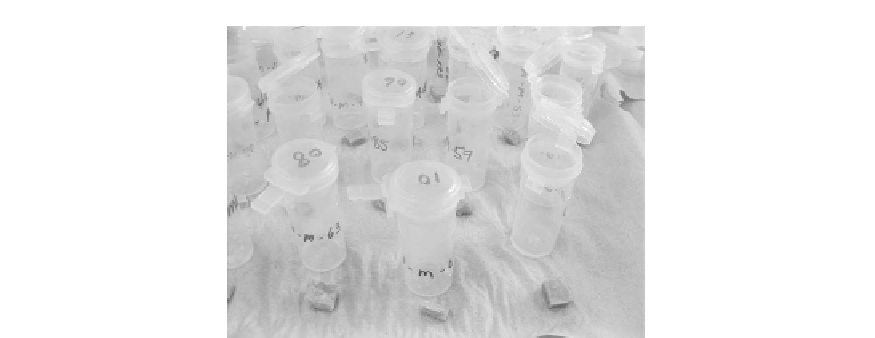Biology Reference
In-Depth Information
FIGURE 13.8
Bone samples drying prior to embedding.
a 3/8-inch plug-cutting bit and a standard electric hand drill. When removing bone
samples for histological analyses, it is important to section areas not affected by
pathology, trauma, or other skeletal abnormalities, unless, of course, the anomaly is the
region of interest.
Embedding and Slide Preparation
The embedding and slide preparatory procedures discussed below are for unaltered
cortical bone samples (following similar approaches utilized by
Ubelaker, 1989
;Stout,
1989a; and
Anderson, 1982
). The term “embedding” refers to the process of fixing small
pieces of bone into a plastic resin. This helps the bone samples maintain integrity
during the preparation of thin sections. Bones with more structural integrity, i.e.,
long bone shafts, do not always necessitate embedding. Samples that are not embedded
are sectioned in a similar process as discussed below but then are affixed to glass slides
with Permount
mounting medium and cover slips. This methodology, however,
makes it more difficult to produce a usable thin section of the ideal size and without
air bubbles. Additionally, this method may be messy and not as durable in the long
term as is embedding.
The technique presented here does not involve either the decalcification of the
bone samples or tissue staining. These processes are not always necessary and depend
on the detail of the variables to be observed and the overall goal of the histological analysis.
Refer to
Maat et al. (2001)
and
Schenk et al. (1984)
for more information on these
procedures.
See
Box 13.1
for a detailed list of simple steps involved for the novice anthropologist con-
ducting histological research. However, the reader should additionally be sure to consult the
following references that detail methods in this area:
An and Martin (2003), Paine (2007)
, and
Cho (2012)
. Further, in line with the advice given elsewhere in this volume (Bethard [Chapter
15]; Cabana et al. [Chapter 16]), when undertaking the methods as outlined in
Box 13.1
, the

